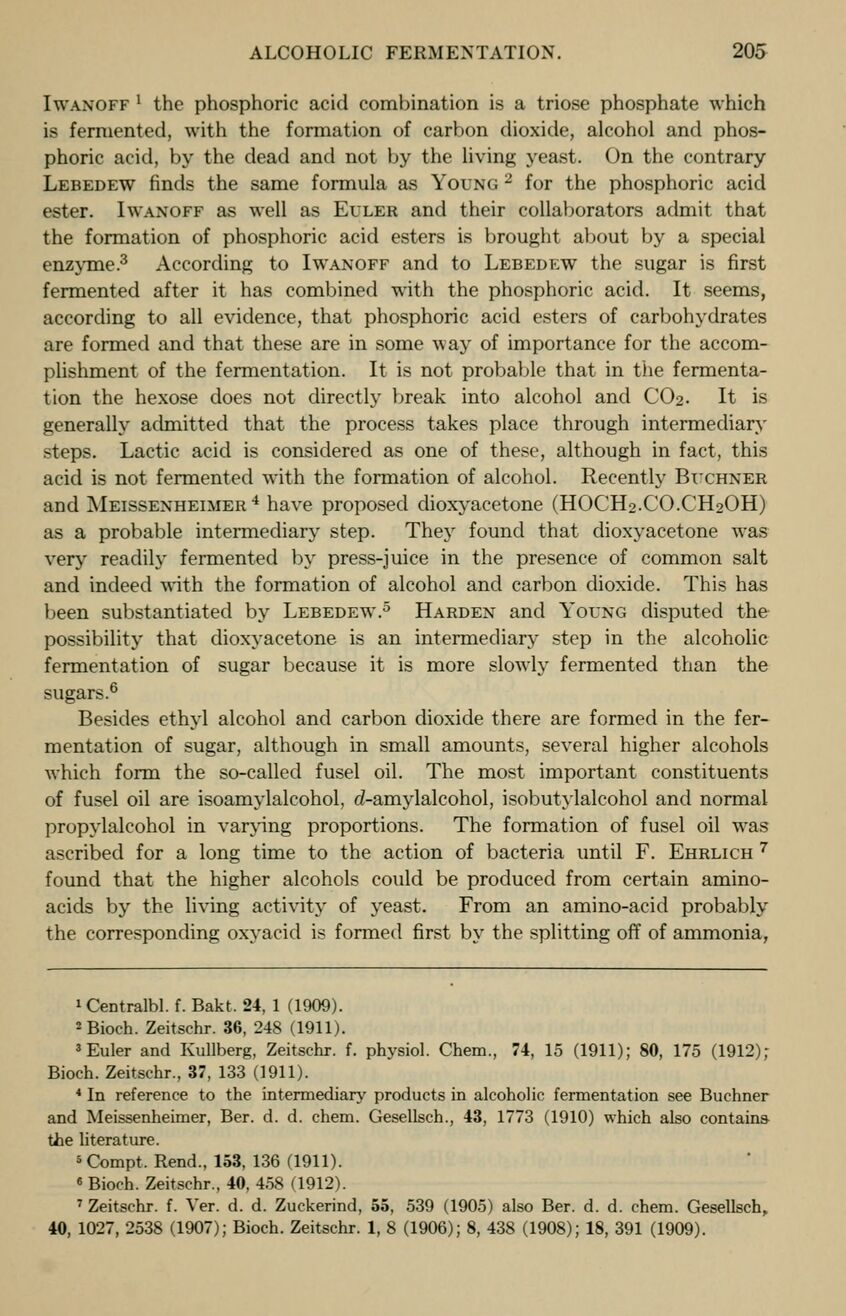
Full resolution (JPEG) - On this page / på denna sida - III. The Carbohydrates - 1. Monosaccharides

<< prev. page << föreg. sida << >> nästa sida >> next page >>
Below is the raw OCR text
from the above scanned image.
Do you see an error? Proofread the page now!
Här nedan syns maskintolkade texten från faksimilbilden ovan.
Ser du något fel? Korrekturläs sidan nu!
This page has never been proofread. / Denna sida har aldrig korrekturlästs.
ALCOHOLIC FERMENTATION. 205
Iwanoff ’ the phosphoric acid combination is a triose phosphate which
is fermented, with the formation of carbon dioxide, alcohol and phos-
phoric acid, by the dead and not by the living yeast. On the contrary
Lebedew finds the same formula as Young 2
for the phosphoric acid
ester. Iwanoff as well as Euler and their collaborators admit that
the formation of phosphoric acid esters is brought about by a special
enzyme.3
According to Iwanoff and to Lebedew the sugar is first
fermented after it has combined with the phosphoric acid. It seems,
according to all evidence, that phosphoric acid esters of carbohydrates
are formed and that these are in some way of importance for the accom-
plishment of the fermentation. It is not probable that in the fermenta-
tion the hexose does not directly break into alcohol and CO2. It is
generally admitted that the process takes place through intermediary
steps. Lactic acid is considered as one of these, although in fact, this
acid is not fermented with the formation of alcohol. Recently Buchner
and Meissenheimer 4
have proposed dioxyacetone (HOCH2.CO.CH2OH)
as a probable intermediary step. They found that dioxyacetone was
very readily fermented by press-juice in the presence of common salt
and indeed with the formation of alcohol and carbon dioxide. This has
been substantiated by Lebedew.5 Harden and Young disputed the
possibility that dioxyacetone is an intermediary step in the alcoholic
fermentation of sugar because it is more slowly fermented than the
sugars.6
Besides ethyl alcohol and carbon dioxide there are formed in the fer-
mentation of sugar, although in small amounts, several higher alcohols
which form the so-called fusel oil. The most important constituents
of fusel oil are isoamylalcohol, t/-amylalcohol, isobutylalcohol and normal
propylalcohol in varying proportions. The formation of fusel oil was
ascribed for a long time to the action of bacteria until F. Ehrlich 7
found that the higher alcohols could be produced from certain amino-
acids by the living activity of yeast. From an amino-acid probably
the corresponding oxyacid is formed first by the splitting off of ammonia,
1
Centralbl. f. Bakt. 24, 1 (1909).
2
Bioch. Zeitschr. 36, 248 (1911).
3
Euler and Kullberg, Zeitschr. f. physiol. Chem., 74, 15 (1911); 80, 175 (1912);
Bioch. Zeitschr., 37, 133 (1911).
4
In reference to the intermediary products in alcoholic fermentation see Buchner
and Meissenheimer, Ber. d. d. chem. Gesellsch., 43, 1773 (1910) which also contains
the literature.
5
Compt. Rend., 153, 136 (1911).
6
Bioch. Zeitschr., 40, 458 (1912).
7
Zeitschr. f. Ver. d. d. Zuckerind, 55, 539 (1905) also Ber. d. d. chem. Gesellsch,
40, 1027, 2538 (1907); Bioch. Zeitschr. 1, 8 (1906); 8, 438 (1908); 18, 391 (1909).
<< prev. page << föreg. sida << >> nästa sida >> next page >>